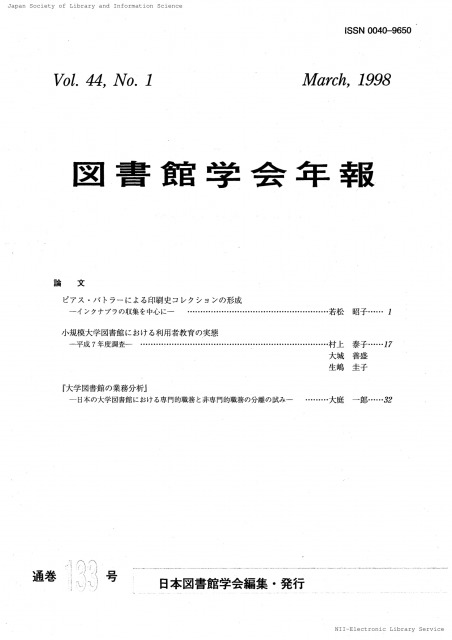巻号一覧

後続誌
31 巻, 1 号
選択された号の論文の9件中1~9を表示しています
- |<
- <
- 1
- >
- >|
特集「現代の図書館学 Ⅱ」
論文
-
河井 弘志原稿種別: 論文
1985 年 31 巻 1 号 p. 1-16
発行日: 1985年
公開日: 2022/10/07
ジャーナル フリーWie die geschichtswissenschaftler in der Geistesgeschichte Europas im 20. Jahrhundert eine große Wendung vom Historismus zur Soziologie fanden, so sah Joris Vorstius (1894-1964) dieselbe Richtung der Entwicklung der Bibliothekswissenschaft in Deutschland, die später W. Schmidt in seinem Vortrag bestätigte.
Vor dem 2. Weltkrieg beschäftigte sich Vorstius mit den bibliographischen Tätigkeiten an der Staats-bibliothek Berlin. Seine Theorie der Bibliographie und Katalogisierung beruhte damals auf den Preusischen Instruktionen, die die Tendez des Histosismus der Philologie in der grammatischen Ordnungsmethode haben.
Nach dem Weltkrieg interessierte er sich mehr für die Bibliotheksbenutzung und Leser als für die Literatur als solche. Er wies auf den Charakter des Historismus in der “buchgeschichtlichen Forschung” von K. Dziatzko und seiner Schule hin, und obwohl er die Nützlichkeit dieser Forschungsrichtung wußte, um das Niveau der Bibliothekswissenschaft und des Bibliothekarstandes zu erhöhen, verlangte er einen neuen “einheitlichen Urgrund” der Bibliothekswissenschaft, der die Benutzer einschloß, damit man auch die öffentliche Bibliothek ins Forschungsgebiet hineinziehen konnte.
Die Grundfunktion der Bibliothek als der Forschungsgegenstand muß die Literaturerschließung und Literaturauswertung sein, die nicht nur die Bücher sondern auch die Benutzer und ihre “literarischen Bedürfnisse” in Betracht ziehen. Die “soziologische Struktur der Leser” kann nun eine der Hauptaufgaben der Forsschung sein.
Die Voraussage von Vorstius erwies sich als richtig, da F. Karstedt, R. Kluth oder andere Forscher der Biblistheksbenutzung in den fogenden Johren die soziologische Richtung der Bibliothekswissenschaft weiter förderten.抄録全体を表示PDF形式でダウンロード (2289K) -
竹内 悊原稿種別: 論文
1985 年 31 巻 1 号 p. 17-24
発行日: 1985年
公開日: 2022/10/07
ジャーナル フリーPDF形式でダウンロード (1065K) -
阪田 蓉子原稿種別: 論文
1985 年 31 巻 1 号 p. 45-46
発行日: 1985年
公開日: 2022/10/07
ジャーナル フリーPDF形式でダウンロード (178K)
一般論文
-
ーもう1つのドキュメンテーション運動一佐藤 隆司原稿種別: 一般論文
1985 年 31 巻 1 号 p. 25-32
発行日: 1985年
公開日: 2022/10/07
ジャーナル フリーIt is a well known fact that the two Belgians Mr. Paul Otlet and Mr. Henri LaFontaine originated documentation activity. But the same kind of activity, even though the term documentation was not used, was also originated by two Swiss, Karl Wilhelm Bührer and Adolf Saager, who have since passed into obscurity. Their ideas were fervently supported by Dr. Wilhelm Ostwald who was the founder of physical chemistry and also a Nobel Prize Laureate. The following is the essence of their ideas.
Various intellectual activities are taking place in various fields of knowledge without any formal coordination, therefore, it is necessary to place ‘bridge' between these intellectual activities. Since these intellectual activities appear in print, the problem is one of organization of printed papers, and to organize effectively, various methods, for instance, standardization of the size of papers and classification, should be introduced.
The original idea of standardizing these papers was formulated by Dr. Ostwald; later these standards evolved into the present standard of the IS0. As the basis of organization, the Decimal Classification as proposed by Melvil Dewey and adopted by Otlet and LaFontaine, was approved as the ‘bridge machinery' by Bührer and Saager. They also proposed what today called ‘bibliographical strip'.
Bührer and Saager developed their ideas and in 1911 published a book entitled “Die Organisierung der geistigen Arbeit durch die Brücke”. ln order to spread their ideas and to shape intellectual activity—their first target being the collection and organization of postcards—they became incorporate. In 1911, the organization was founded in Munich with Dr. Ostwald as chairperson and Bührer and Saager in charge of the whole undertaking. Dr. Ostwald donated almost all his Nobel Prize money to this organization in Munich.
Among the supporters of the organization were distinguished European scholars, men of culture, and politicians. Among them the name of Otlet and Solvay who were sponsors of the Institut International de Bibliographie, started by Otlet and LaFontaine, were to be seen. The organization in Munich gradually declined due to Bührer's obsession with trivial matters and his poor health. By 1913, there were very few activities going on in the organization.
Hewever, at its height of activity, the organization produced more than 30 pamphlets, collected enormous amount of postcards which it was not able to organize fully, and held an exhibition of stationery and office equipment.
For example, the 1919 publication by D. Ostwald “Die chemische Literatur und die Organisation der Wissenschaft” showed the effect of his cooperative experience with Bührer and Saager. Moreover, in 1911, Dr. Friedrich Kuntze, Professor of Philosophy at the University of Berlin, contributed an article strongly in favor of the 'bridge' method to a critical journal “Der Kunstwart”. Later he made use of this experience of the 'bridge' method in his work “Die Technik der geistigen Arbeit”.
Although the organization of Bührer and Saager was a weak one and did not survive long, it is important to evaluate their contribution in our present information society.抄録全体を表示PDF形式でダウンロード (1043K)
紹介
-
石山 洋原稿種別: 紹介
1985 年 31 巻 1 号 p. 43-44
発行日: 1985年
公開日: 2022/10/07
ジャーナル フリーPDF形式でダウンロード (302K)
学会記事
-
原稿種別: 学会記事
1985 年 31 巻 1 号 p. 33-42,32
発行日: 1985年
公開日: 2022/10/07
ジャーナル フリーPDF形式でダウンロード (1500K)
海外ニュース
-
石山 洋原稿種別: 海外ニュース
1985 年 31 巻 1 号 p. 16
発行日: 1985年
公開日: 2022/10/07
ジャーナル フリーPDF形式でダウンロード (135K) -
石山 洋原稿種別: 海外ニュース
1985 年 31 巻 1 号 p. 48
発行日: 1985年
公開日: 2022/10/07
ジャーナル フリーPDF形式でダウンロード (141K)
サマリー
-
原稿種別: Summary
1985 年 31 巻 1 号 p. 46-47
発行日: 1985年
公開日: 2022/10/07
ジャーナル フリーPDF形式でダウンロード (172K)
- |<
- <
- 1
- >
- >|